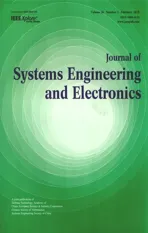Dynamic channel reservation scheme based on priorities in LEO satellite systems
2015-01-17JianZhouXiaoguoYeYongPanFuXiaoandLijuanSun
Jian Zhou,Xiaoguo Ye,Yong Pan,Fu Xiao,and Lijuan Sun
College of Computer,Nanjing University of Posts and Telecommunications,Nanjing 210003,China
Dynamic channel reservation scheme based on priorities in LEO satellite systems
Jian Zhou*,Xiaoguo Ye,Yong Pan,Fu Xiao,and Lijuan Sun
College of Computer,Nanjing University of Posts and Telecommunications,Nanjing 210003,China
According to low earth orbit(LEO)satellite systems with users of different levels,a dynamic channel reservation scheme based on priorities is proposed.Dynamic calculation of the thresholds for reserved channels is the key of this strategy.In order to obtain the optimal thresholds,the traffc is predicted based on the high-speed deterministic movement property of LEO satellites frstly.Then,a channel allocation model based on Markov is established.Finally,the solution of the model is obtained based on the genetic algorithm.Without user location,this strategy effectively reduces handover failures and improves channel utilization by adjusting dynamically the thresholds according to traffc conditions.The simulation results show that the system’s overall quality of service can be improved by this strategy.
dynamic channel reservation,priority,handover,different level user,low earth orbit(LEO).
1.Introduction
Low earth orbit(LEO)satellite systems have some very promising properties in providing global coverage realtime mobile communication services to small handheld mobile terminals.Compared with geostationary(GEO) satellite systems,LEO satellite systems require lower transmit power and have the advantage of signifcantly shorter transmission delays.However,due to high-speed movement of LEO satellites,handovers occur rather frequently during a call’s lifetime in LEO satellite systems.If there is no suffcient number of channels available in the adjacent cell during the handover process,the handover drops.It is well known that handover failures are much more destructive and undesirable than new calls being blocked.Thus,strategies prioritizing handover calls over new calls are of great importance.
Channel reservation is a channel allocation strategy for guaranteeing the priority.The channel reservation strategy in the terrestrial cellular system,which has been studied in[1–3],is comparatively ripe.Compared with the terrestrial cellular system,handover in LEO satellite systems is much more frequent.However,regularity and periodicity of orbital motion of LEO satellites make the handover process predictable.It will help to reduce the handover drop by making full use of the characteristics of LEO satellites in design of the channel reservation strategy.
The guaranteed handover(GH)scheme proposed by Maral et al.[4]is the earliest channel reservation scheme for satellite systems.Based on the GH scheme,a series of improved schemes have been proposed,such as dynamic Doppler-based handover priortization scheme(DDBHP) [5]and dynamic time-based channel reservation(DTCR) [6].However,the number of reserved channels in these schemes is fxed and cannot be dynamically adjusted, which causes poor channel utilization.Dynamic channel reservation schemes have been studied in[7–10],but the proposed schemes require user locations and depend on positioning devices,e.g.GPS,which increases the complexity of terminals and signaling cost for location information.
Moreover,there are users of different levels in LEO satellite systems,such as military user,government user and business user.The higher level user requires better service quality,while the lower level user has tolerance capacity to a certain extent for call drop.Therefore,not only the call type but also the user level shall be considered in design of the channel reservation strategy for LEO satellite systems.
In this paper,we propose a novel dynamic channel reservation scheme based on priorities(DCRP)that are used in LEO satellite systems with users of different levels.On the basis of the deterministic and predictable LEO satellite motion,user location is not required in our scheme.With the target of the system’s overall quality of service,the number of channels in a cell,which are reserved for users of different levels and for calls of different types,iscalculated dynamically according to traffc conditions.
The remainder of this paper is structured as follows.Section 2 presents the proposed scheme.In Section 3, the traffc prediction based on the LEO satellite mobility is discussed.The channel allocation model is built based on the Markov process in Section 4.In Section 5,the solution of thresholds based on genetic algorithm is described.Section 6 presents and discusses simulation results.Finally, conclusions are drawn in Section 7.
2.DCRP
Considering an LEO satellite system with users of S= {1,2,...,i,...,s}levels(which are in an ascending order),we strictly divide the channels in accordance with priorities.Since the higher level user requires better service quality,the handover call and the new call of the“i+1”level user can use more channels than the“i”level user.Fixed channel allocation(FCA)is used in the system.Assume C is the number of channels assigned to each cell.Then,we use 2s thresholds K = {k1,k′1,k2,k′2,...,ki,k′i,...,ks,k′s}to distribute channels,where 0≤ k1≤ k′1≤ k2≤ k′2≤ ···≤ ki≤k′i≤···≤ks≤k′s≤C.Among them,kidenotes the admission threshold for the new call of the“i”level user, and k′idenotes the admission threshold for the handover call of the“i”level user.The channel allocation is shown in Fig.1.

Fig.1 Dynamic channel reservation using 2s thresholds
The steps of the DCRP are as follows:
Step 1At the set-up time,K is set to the fxed number based on the fxed channel reservation(FCR) scheme.When the system is running,dynamically calculate the value of K.The calculation method will be discussed in the following sections.The system updates the value of K each interval.
Step 2If one call requests for access,the system judges the user level and the call type of this call frstly.Take the“i”level user call for example.If the“i”level user call is a new call,the process will move to Step3. If it is a handover call,the process will move to Step 4.
Step 3If the current number of occupied channels is less than ki,the system accepts the new call of the“i”level user.Otherwise the system blocks it.
Step 4If the current number of occupied channels is less thanthe system accepts the handover call of the“i” level user.Otherwise the system blocks it.
For calls of different types,the more channels reserved for handover calls,the needs of handover are more likely to be satisfed.Therefore,the handover failure probability can be effectively reduced.However,reducing the number of available channels will refuse more new calls and then will increase the new call blocking probability.
For users of different levels,the more channels reserved for the high level user,the higher service quality of the high level user can be ensured.However,the low level user cannot use the reserved channel even if there is no high level user,which leads to poor channel utilization.
The key of channel reservation is to reserve channels reasonably for the handover call with little impacting on the new call blocking probability and to improve the service quality of the high level user while ensuring the service quality of the low level user.Therefore,dynamically calculation of thresholds is particularly critical.In this paper,the following work is to seek the optimal thresholds K to improve the channel utilization and the system’s overall quality of service.
3.Traffc prediction based on LEO satellite mobility
3.1LEO satellite mobility
In order to improve the capacity of satellite systems and the utilization of limited spectra,the modern satellite systems generally use multispot-beam for frequency reuse.Each multispot-beam antenna from a single satellite irradiates on the earth a regular honeycomb cellular network,and the footprint of each satellite contains circular adjacent cells corresponding to the satellite multispot-beams.
Due to the very high LEO satellite speed,user motion and earth rotation speed are neglected.For example, the satellite ground-track speed of Iridium and Globalstar systems are 26 600 km/h and 21 092 km/h respectively.Therefore,users can be considered as fxed,and handover in LEO satellite systems is mainly caused by the high-speed movement of LEO satellites[11].Thus,user motion,which is simplifed to linear motion,could be approximated by the satellite ground-track speed,and the destination cell for any user will be the adjacent cell in the opposite direction of the satellite motion,as shown in Fig.2.
Each cell is modeled as a circle area with a diameter of D.In order to guarantee the continuous coverage,the overlap exists between the adjacent cells or the adjacent satellites.The velocity of satellite movement is denoted as V.The maximum dwell time of a call in a cell is denoted as tmax,and tmax=D/V.Given the uniform position of users and the uniform arrivals of new calls in a cell,the maximum dwell time of the new call in a cell(TN)follows uniform distribution between 0 and tmax.Due to the highspeed movement of LEO satellites,the maximum dwell time of the handover call in a cell(TQ)is equal to tmax.
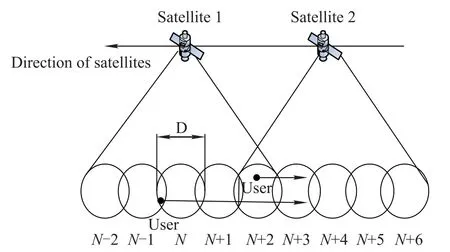
Fig.2 LEO satellite mobility
3.2Traffc prediction

The call duration(TC)of different level users is assumed to be exponentially distributed with a parameter u.According to the LEO satellite mobility and the memoryless property of the exponential distribution,the channel holding time of the new call in its originating cell is TNW=min(TN,TC).Since there is little probability that new call ends immediately in its originating cell,we assume TNW=TN.The channel holding time of the handover call in its transit cell is TQW=min(TQ,TC)= TC.And we can get E(TNW)=tmax/2,E(TQW)= 1/u.Therefore,the average departure rate of the calls can be derived as μend=1/(PNWE(TNW)+PQWE(TQW)). Among them,PNWis the probability that the call is a new call,and PNW= λn/(λn+λq).PQWis the probability that the call is a handover call,and PQW=λq/(λn+ λq).λndenotes the new call arrival rate,and λqdenotes the handover call arrival rate.

4.Channel allocation model based on Markov
Based on the traffc prediction in Section 3,each cell can be modeled by an M/M/C/C Markov process with state space.The state is defned as the sum of the number of channels in use,and its state transition diagram is illustrated in Fig.3.

Fig.3 State transition diagram for our scheme
Let πjbe the steady state probability of the state j, which refers to j channels that are occupied.The global balance equations for this Markov process are as follows:

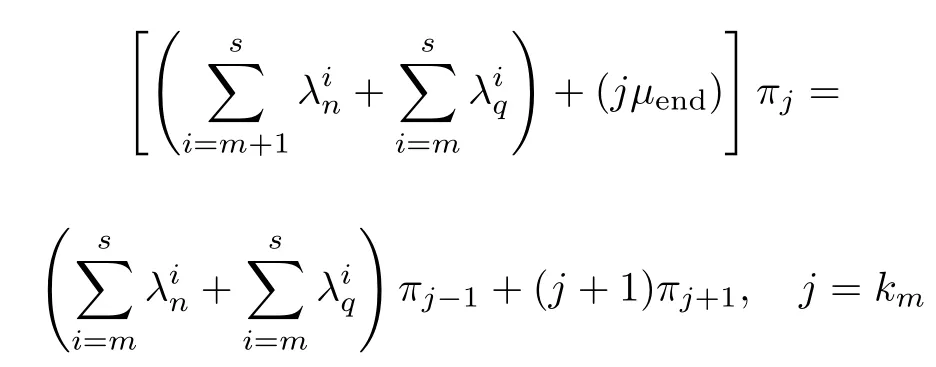




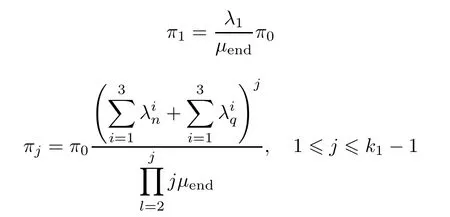


The calculation of λinand μendis shown in Section 3.2. We can obtain QoS=f(K).
Through the analysis above,we establish the following channel allocation model:

In practice,as the system capacity C and the user level S increase,the computation requirements of thresholds K quickly become excessive.A very long solution time and great storage space are required if the exhaustive search algorithm is used.Therefore,the solution of thresholds becomes an NP-hard problem.
5.Solution of thresholds based on genetic algorithm
The genetic algorithm is a random search algorithm that simulates the processes of biological evolution and genetics.It uses the genetic operator to search in the problem space and uses the adaptive value to evaluate the candidate solution.Compared with traditional algorithms,the genetic algorithm has the superiority in solving the complex problems.In addition,the genetic algorithm can seek the suitable K in limited time by restricting evolution generations,to control the solution time.We solve the channel allocation model established in Section 4 on the basis of the genetic algorithm.The steps are shown in Fig.4.

Fig.4 Solution steps based on genetic algorithm
The key steps of the solution above are introduced as follows:
Step 1Coding
Use the real number encoding method.An ordered K= {k1,k2,...,ki,...,k2s}is a chromosome.
Step 2Initial population
Use the random generation method to initialize population.The steps are as follows:
Step 2.1At the beginning,K={∅},k=0,n=0;
Step 2.2k=rand(0,C),K=K∪k,n++;
Step 2.3if n<2s,move to Step 2.2.Else,move to Step 2.4;
Step 2.4Sort K in an ascending order to generate a valid chromosome.
Step 3Selection operation
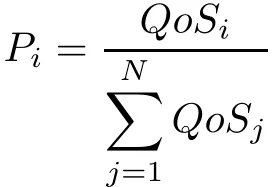
Step 4Crossover operation
A random integer p(0<p<2s)is selected,and two new chromosomes are generated when two former chromosomes go through with the crossover operation at the point p.Sort the new chromosomes in the ascending order.
Step 5Mutation operation
On the premise that ki−1/=ki+1,select a kiin K randomly and set ki=rand(ki−1,ki+1).
6.Simulation
This section discusses the simulation results obtained using the DCRP,compared with FCR and time-based channel reservation algorithm(TCRA)[10].During the simulation process,the following assumptions related to the traffc model are made:
(i)Normal users,senior users and military users(S= {1,2,3})are considered.
(ii)Each cell has a fxed number of channels C equal to 100,and the cell diameter D is 425 000 m in this case.
(iii)Iridium is adopted as the basic system model.The satellite ground track velocity V is 7 388.9 m/s,so tmax= D/V=57.519 s.
(iv)The call duration TCof different level users is assumed to be exponentially distributed with u = 1/180 s.The new calls are assumed to arrive according to a Poisson process with mean rate λn.For different level users,λ1n=λ2n=λ3n=λn/3.
(v)To maintain the necessary accuracy for the simulations,the following numerical values are chosen:α0=1, α1=10,β1=0.2,β2=0.3,β3=0.5.At the setup time,according to FCR,K is set to{k1=75,k′1= 80,k2=85,k′2=90,k3=95,k′3=100}.In the genetic algorithm,evolution generations are set to 20,and the population size is set to 100.
Figs.5–11 show the comparison of simulation results for DCRP,TCRA and FCR schemes in terms of the handover failure probability,the new call blocking probability and quality of service.The curves are represented as a function of traffc intensity.Changing traffc intensity by increasing λn,it can be seen that the new call blocking probability and the handover failure probability increase accordingly.However,results show clearly that the handover failure probability is lower than the new call blocking probability because each of the three schemes assigns high priority to handover requests.
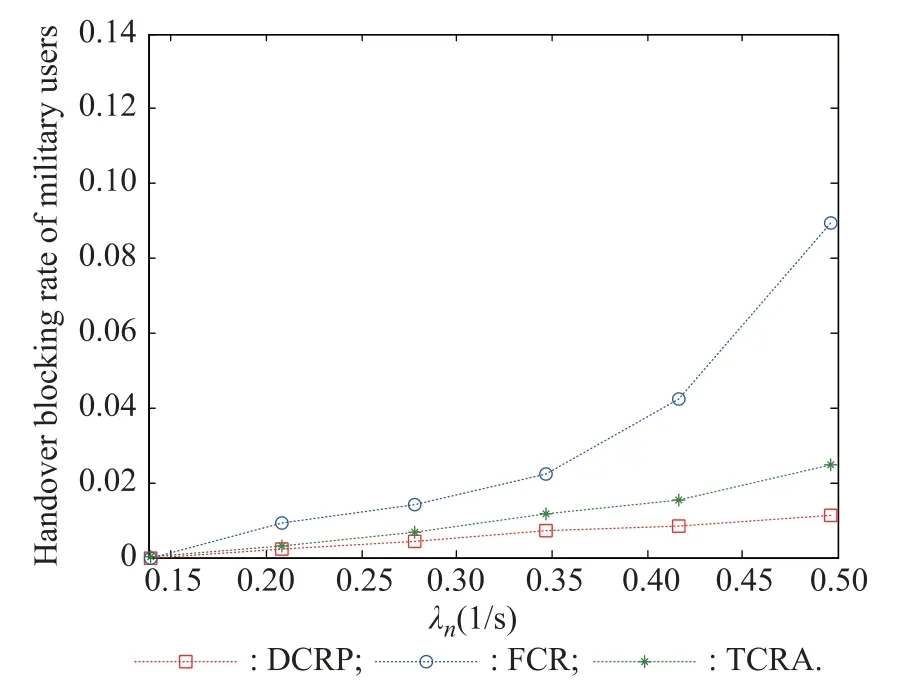
Fig.5 Handover failure probability of military users
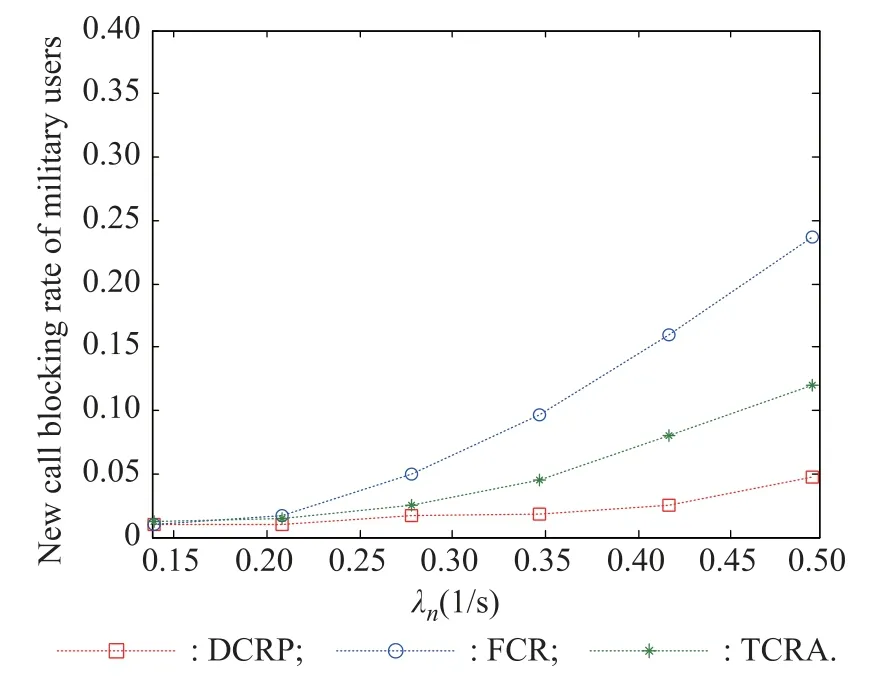
Fig.6 New call blocking probability of military users
Figs.5 and 6 respectively compare the handover failure probability and new call blocking probability of military users between DCRP,TCRA and FCR.Clearly, DCRP achieves signifcantly better performances for military users compared with TCRA and FCR in terms of the handover failure probability and the new call blocking probability.
In Fig.7,for senior users with light traffc,DCRP has the same number of handover failures with TCRA.However,when traffc intensity is heavy,TCRA has a lower number of handover failures than DCRP.For senior users, Fig.8 shows that DCRP has a lower number of handover failures than FCR,but higher than TCRA.Nonetheless,it should also be noted that TCRA requires user location and depends on positioning devices,which increases the complexity of terminals and signaling cost for location information.

Fig.7 Handover failure probability of senior users

Fig.8 New call blocking probability of senior users
In Fig.9,it can be seen that,for normal users,the handover failure probability of DCRP is lower than FCR when traffc intensity is low.With the increase of traffc intensity,the handover failure probability of DCRP becomes higher than FCR.In Fig.10,in terms of the new call blocking probability of normal users,the difference of the three schemes is not clearly when traffc intensity is low.Nonetheless,with heavy traffc,the new call blocking probability of DCRP is the highest.
We can easily note that,from Figs.5–10,DCRP allows a signifcant reduction of the handover failure probability and the new call blocking probability of military users, compared with the results shown by TCRA and FCR.This improvement is due to the fact that DCRP gives high priority to the high level user.This allows the military user to have a higher chance to achieve successful calls,at the expense of the minor increase of the handover failure probability and the new call blocking probability of the normal user.
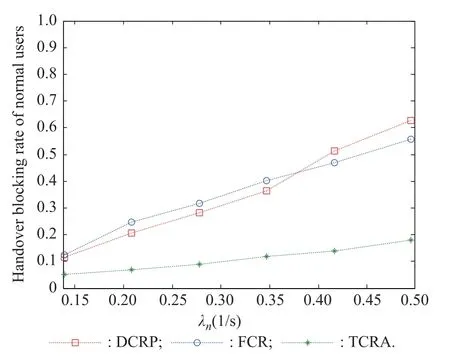
Fig.9 Handover failure probability of normal users

Fig.10 New call blocking probability of normal users
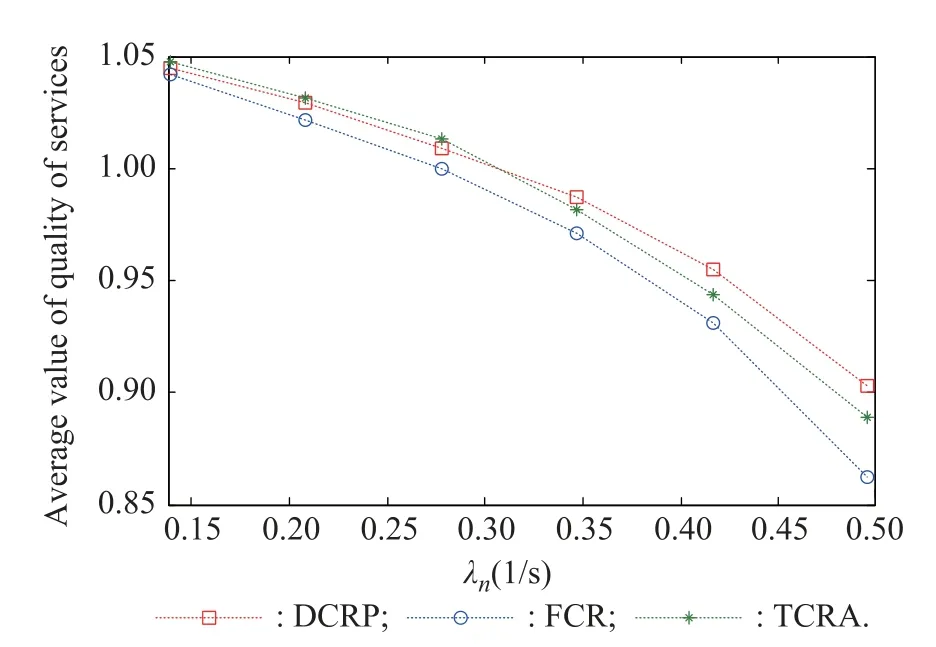
Fig.11 Quality of services of each level of users
Fig.11 shows that DCRP leads to better quality of services compared with FCR because reservations are adjusted according to traffc conditions.It is also shown that DCRP obtains little better QoS than TCRA because there is less military user call being blocked.
Therefore,it is clear that the proposed DCRP method provides an effective way to reduce the cost of channel reservation.In contrast,FCR tends to waste channel resources by unnecessarily reserving too many channels when traffc is light or results in higher handover failures when the traffc is heavy.This happens because of the fxed reservation,which,obviously,does not take into account traffc conditions.
DCRP has more fexibility to fne-tune the thresholds for each level of users and can adapt better to the needs of different level users,thus achieving better performances than TCRA.Furthermore,there is no user location required by DCRP.
7.Conclusions
In this paper,we have proposed a novel DCRP for LEO satellite systems which support different level users.The proposed scheme is based on the feature that,in LEO satellite systems,traffc can be predicted according to the deterministic and predictable satellite motion.To calculate thresholds dynamically for channel reservation,the channel allocation model has been established based on the Markov process.In addition,the solution of the model based on the genetic algorithm has been developed to obtain thresholds in limited time.The simulation results have shown that the proposed scheme can effectively reduce handover failures and offer more fexibility for allocating channel resources to different level users by adjusting the thresholds to cope with changing traffc conditions.Moreover,without the requirements for location information of the terminals,the proposed scheme can improve the system’s overall quality of services.
[1]P.V.Krishna,S.Misra,M.S.Obaidat,et al.An effcient approach for distributed dynamic channel allocation with queues for real-time and non-real-time traffc in cellular networks. Journal of Systems and Software,2009,82(7):1112–1124.
[2]L.R.Tang,A.K.Yang,X.Yang.A baton handover strategy based on channel reservation and preemptive priority.ACTA Electronica Sinica,2011,39(6):1285–1290.(in Chinese)
[3]W.X.Shi,J.Zhao,X.F.Chi,et al.Fast dynamic channel allocation algorithm based on priority channel reservation.Journal on Communications,2009,30(7):59–66.(in Chinese)
[4]G.Maral,J.Restrepo,E.Delre,et al.Performance analysis for a guaranteed handover service in an LEO constellation with a‘satellite-fxed cell’system.IEEE Trans.on Vehicular Technology,1998,47(4):1200–1214.
[5]E.Papapetrou,F.N.Pavlidou.Analytic study of Dopplerbased handover management in LEO satellite systems.IEEE Trans.on Aerospace and Electronic Systems,2005,41(3): 830–839.
[6]S.Karapantazis,F.N.Pavlidou.Dynamic time-based handover management in LEO satellite systems.Electronics Letters,2007,43(5):57–58.
[7]P.Evangelos,T.Petia,K.Stylianos,et al.Adaptive handover management for multiservice NGSO satellite systems.Proc.of the 18th Annual IEEE International Symposium on Personal, Indoor and Mobile Radio Communications,2007:1–5.
[8]Z.P.Wang,P.T.Mathiopoulos,R.Schober.Channeling partitioning policies for multi-class traffc in LEO-MSS.IEEE Trans.on Aerospace and Electronic Systems,2009,45(4): 1320–1334.
[9]D.Ding,D.T.Ma,J.B.Wei,et al.Optimal call admission control and handover management scheme in multi service LEO satellite networks.Journal of Electronics&Information Technology,2010,32(7):1559–1563.(in Chinese)
[10]L.Boukhatem,A.L.Beylot,D.Ga¨ıti,et al.TCRA:a timebased channel reservation scheme for handover requests in LEO satellite systems.International Journal of Satellite Communications and Networking,2003,21(3):227–240.
[11]N.N.Hoang,S.Olariu,P.Todorova.A novel mobility model and resource reservation strategy for multimedia LEO satellite networks.Proc.of the Wireless Communications and Networking Conference,2002:832–836.
[12]C.Sungrae.Adaptive dynamic channel allocation scheme for spotbeam handover in LEO satellite networks.Proc.of the IEEE Vehicular Technology Conference,2000:1925–1929.
Biographies

Jian Zhou was born in 1984.He received his Ph.D.degree from Nanjing University of Science and Technology in 2012.Now he is working as a lecturer in Nanjing University of Posts and Telecommunications.His research interests are satellite network and complexity science.
E-mail:zhoujian@njupt.edu.cn

Xiaoguo Ye was born in 1975.He received his Ph.D. degree from Southeast University in2005.Now he is an associate professor in Nanjing University of Posts and Telecommunications.His research interests are satellite network and sensor network.
E-mail:xgye@njupt.edu.cn

Yong Pan was born in 1988.He received his B.S.degree from Nanjing University of Posts and Telecommunications.Now he is working for his M.S.degree in Nanjing University of Posts and Telecommunications.His research interest is satellite network.
E-mail:lucfnil919@126.com

FuXiao was born in1980.He received his Ph.D.degree from Nanjing University of Science and Technology in 2007.Now he is a professor in Nanjing University of Posts and Telecommunications.His research interests are satellite network and sensor network.
E-mail:xiaof@njupt.edu.cn

Lijuan Sun was born in 1963.She received her Ph.D.degree from Nanjing University of Posts and Telecommunications in 2008.Now She is a professor and a Ph.D.candidate supervisor in Nanjing University of Posts and Telecommunications.Her main research interest is computer network.
E-mail:sunlj@njupt.edu.cn
10.1109/JSEE.2015.00001
Manuscript received January 24,2014.
*Corresponding author.
This work was supported by the National Natural Science Foundation of China(71301081;61373137)and the Natural Science Foundation of Jiangsu Province(BK20130877;BK2012833).
杂志排行
Journal of Systems Engineering and Electronics的其它文章
- Adaptive beamforming and phase bias compensation for GNSS receiver
- Novel dual-band antenna for multi-mode GNSS applications
- Nonparametric TOA estimators for low-resolution IR-UWB digital receiver
- Effcient hybrid method for time reversal superresolution imaging
- Adaptive detection in the presence of signal mismatch
- Estimating DOA and polarization with spatially spread loop and dipole pair array
